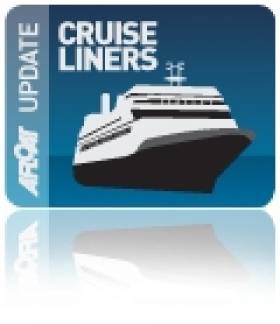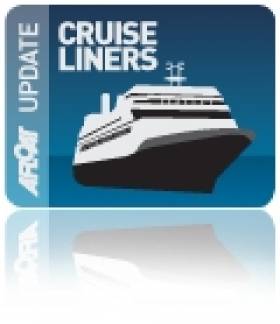Displaying items by tag: Dublin Bay Ports
#DublinBayCalls – A small cruise ship but big on levels of luxury is visiting Dublin Port today and this day next week is scheduled to call to neighbouring Dun Laoghaire Harbour, writes Jehan Ashmore.
After undergoing a multi-million pound refurbishment in Sweden during the Spring, the former Sea Explorer of 4,200 tonnes which had spent a ‘lay-up’ mode in Dun Laoghaire in recent years, has been re-launched under new name MS Hebridean Sky.
The refurbishment undertaken on the 90m cruiseship involved numerous works to the 114-passenger guest capacity ship’s public rooms and five-decks as well as to the accommodation for 72 crew.
In addition during dry-docking numerous technical work was carried out for the vessel's operator, Noble Caledonia which specialises in the small-ship cruising market offering a wide range of luxury vessels to travel to destinations as diverse as the Artic and Papua New Guinea in the south-west Pacific.
Hebridean Sky is one of three flagships and is a sister of MS Island Sky and MS Caledonian Sky. The trio were built in the early 1990’s at the same ship yard in Italy and share attributes that make them among some of the finest small ships in the world. Luxury is enhanced by the use of wood panelling and brass which predominates throughout conveying the atmosphere of a private yacht.
There are 59 spacious suites which have a sitting room area and some have private balconies.
Accommodation is arranged over five decks and all suites have outside views with suites on the Scott and Shackleton decks featuring private balconies. Each suite affords comfort with en-suite bathroom of a marble-topped vanity unit with sink and walk-in shower. Among the suites features are a mini-fridge, flat screen TV with inbuilt DVD/CD player and telephone.
#RepeatReverseRole – MSC Splendida repeated a reverse docking call to Dublin Port today following the same unorthodox berthing procedure of only the previous week, writes Jehan Ashmore.
Operators of the largest ship ever to dock in the capital, MSC Cruises cited their decision to call to Dublin Port having cancelled a scheduled anchorage call off Dun Laoghaire Harbour for today was due to positive passenger feedback been so close to the city, allowing more time to spend ashore.
In fact the visit of the 3,200 capacity MSC Splendida is much longer than the average port of call at almost a total of 31 hours berthed alongside Alexandra Basin West. The longest quay for such massive cruiseships was reserved for the port's longest ever cruiseship at 333m. As such this prevented her to swing in the confines of the turning circle hence an arrival astern to berth in the basin.
She departs from the basin's Ocean Pier at 23.00 tonight.
The decision to change Dublin Bay destination is a double blow to Dun Laoghaire Harbour Company which expressed dismay as this was the second time MSC Cruises have cancelled. The massive cruiseship was to launch the season on 11 May. This would of involved the transfer of passengers ashore by tenders to and from the harbour.
Instead the first caller of a now reduced record-breaking season of 22 callers to Dun Laoghaire was left to Princess Cruises 3,600 passenger Royal Princess which made her maiden call off the harbour last week.
It will be a case of deja-vu not just because of today's MSC Splendida's repeat reverse call but that Royal Princess is to cancel her next call this Sunday off Dun Laoghaire. She is to steer a course across the bay for a first call to Dublin Port with an arrival time from 05.30.
In the meantime, tonight the 3,900 passenger capacity MSC Splendida is to depart at 23.00 and head northwards to Greenock Cruise Terminal on the Clyde.
The Scottish terminal is where Queen Mary 2 docked today having made her second call in as many years yesterday off Dun Laoghaire Harbour bringing up to 3,000 passengers to visit the borough and beyond.
Rival Sail-Assisted Cruiseship Sisters Come & Go
#RivalSisters – Wind Surf, the one part sailing yacht and one part upscale cruise ship departed Dun Laoghaire Harbour this evening, her rival sister, Club Med 2 is due to call to neighbouring Dublin Port tomorrow, writes Jehan Ashmore.
The largest ship in the Windstar Cruises fleet at 14,746 tonnes represented the final of four cruise callers to Dun Laoghaire this season. Since the harbour re-launched the cruise business in 2011, Wind Surf has been the most regular visitor, today marked her fourth time berthing at Carlisle Pier.
Next year, Dun Laoghaire is to welcome a record 23 cruiseships, including considerably larger callers and as previously reported newbuilds, notably P&O Cruises giant 141,000 tonnes Brittania. Her call in her inaugural season is a major coup for the harbour, as she is the largest ever cruiseship built for the UK market.
Combined these callers are to bring 66,000 passengers to Dun Laoghaire, a figure that surpasses for the first time ever to those visiting Dublin of around 60,000 visitors.
Wind Surf was launched for Club Med at a shipyard in Le Havre as their Club Med 1. This evening the Bahamas flagged vessel is on a course along the eastern Leinster seaboard. She is bound for an anchorage call off Dunmore East tomorrow.
Her former fleetmate sister, Club Med 2, which has a slightly larger tonnage of 14,983 is this evening off the Mull of Kintyre bound for Dublin. She is registered in Mata-Utu, the capital of Wallis and Futuna which is an overseas 'collectivity' of France. She will dock along Ocean Pier.
The 187m (637ft) sisters have five masts each and seven triangular self-furling, computer operated sails, which make for an impressive sight. They are known for luxurious amenities and for reaching to unique ports of call, taking some 310 guests and almost 200 crew.
Cruiseships Large & Small Visit Competing Dublin Bay Ports on Day of Casting of the Spear
#CruiseDublinBay – Two cruiseships one large the other small, yesterday visited separately Dublin Port and Dun Laoghaire Harbour, the later destination welcoming its first caller this year, writes Jehan Ashmore.
Princess Cruises 3,082 passenger capacity Emerald Princess (2007/118,681grt) docked in Dublin, having sailed from Cork overnight while Island Sky (1992/4,200grt) called to Dun Loaghaire after also picked up a pilot in the bay having sailed from Waterford city-centre.
The Noble Caledonia operated Island Sky is on a 'Gardening' themed cruise with 87 passengers out of a 114 total capacity, making visits of spectacular gardens in bloom and earlier today she docked in Holyhead.
Meanwhile, Emerald Princess is heading through the English Channel this evening in the busy shipping lane off Alderney and understood to be bound for Zeebrugge, Belgium.
Emerald Princess call to Dublin Port involved her berth at Ocean Pier west, which is close to the proposed €30m cruise terminal that forms part of the €200m Alexandra Basin Redevelopment (ABR) Project. This year the port is scheduled for around 90 callers.
Further upriver along Sir John Rogerson Quay, St. Bridget of Dublin Bay Cruises was moored at her berth opposite the Convention Centre. The landmark is an easy reference point to where passengers board and disembark on excursions to Howth, Dun Laoghaire and from that harbour a late afternoon cruise is offered to Killiney Bay.
On the Liffey, the shipping scene yesterday notably focused on the sheer presence of Emerald Princess which could be seen in the distance downriver, even before St. Bridget set off on a special short cruise through the East-Link bridge and beyond to the port channel.
In a becalmed sea, Lord Mayor of Dublin, Oisin Quinn was kept busy having launched a new Dublin – Land & Sea ticket in conjunction with Dublin Bus Tours followed by a photocall for a Dublin based councillor as a candidate of the forthcoming European elections. Not to mention the honorary role of the mayor as Admiral of Dublin Port, where such duties were performed for the annual tradition of 'casting of the spear'.
The ceremonial tradition dates back to 1488 when Lord Mayor, Thomas Mayler, according to historical records set out on his horse to ride across the strand and to cast the spear and from wherever it landed marked the city's boundaries.
Looking across the present day strand of south Dublin Bay, is the structure of Dun Laoghaire Harbour with its fine piers jutting into the sea from where the Island Sky arrived into port, the first of four to call this season.
Among them is another newcomer, Seabourn Legend of the luxury Seabourn Cruises fleet of large private yacht-like ships. She is due to call in August.
Likewise of Dublin Port, the Dun Laoghaire Harbour Company, also propose a dedicated cruise terminal costing €17m, so to handle even larger vessels such as Emerald Princess, in which the capital port have also factored into in terms of their terminal design plans.
According to the vessels survey schedules, RV Celtic Explorer had today completed fisheries demersal surveys which started in Galway on 23 September. The near fortnight-long survey was conducted in the ICES area VI, under the direction of chief scientist, Dave Stokes.
On Friday she embarks on a herring acoustic survey which is to take place in the Celtic Sea and the south-west. This survey will be under chief scientist Ciaran O'Donnell and is to de-mobilise in Cork on 27 October. To read more about her 2011 survey programme click HERE.
Across Dublin Bay in neighbouring Dun Laoghaire, the 31m RV Celtic Voyager is currently nearing the end of a month-long hydrography survey of the Celtic Sea. The survey had started in Howth Harbour on 17 September under chief scientist Kevin Sheehan. For the time-being she remains moored in Dun Laoghaire prior to resuming survey work which will continue until the vessel de-mobilises in Rosslare in mid-October. To find out more about her remaining surveys for this year click HERE.
On the surveys outlined they are conducted on behalf of Marine Institute scientists, though the vessels are also allocated ship-time for use of third parties. These include government departments and agencies, universities, research institutes and industry. For further information on the research vessels, survey schedules etc can be found by visiting: www.marine.ie/home/Research+Vessels.htm




























































